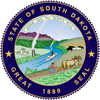
 South Dakota
South Dakota
South Dakota has a constitutional supermajority requirement to raise taxes under Article XI Section 13-14 of the South Dakota Constitution. This was first enacted in 1978 by legislative referendum and then amended by voter approval in 1996 to apply to new taxes. The current version requires a 2/3 supermajority vote in the legislature or by a public vote to raise tax rates on existing taxes or for the legislature to create new taxes.
| Year | Inflation-adjusted Actual Spending |
|---|---|
| 1992 | 1,602,481,119 |
| 1993 | 1,614,057,889 |
| 1994 | 1,703,655,269 |
| 1995 | 1,703,636,451 |
| 1996 | 1,691,610,431 |
| 1997 | 1,840,842,070 |
| 1998 | 1,939,789,826 |
| 1999 | 1,984,135,618 |
| 2000 | 2,084,365,233 |
| 2001 | 2,177,584,963 |
| 2002 | 3,385,855,672 |
| 2003 | 2,251,569,046 |
| 2004 | 2,831,165,380 |
| 2005 | 2,379,421,676 |
| 2006 | 2,476,418,708 |
| 2007 | 2,490,835,895 |
| 2008 | 2,648,545,369 |
| 2009 | 2,808,374,384 |
| 2010 | 2,702,548,511 |
| 2011 | 2,739,649,975 |
| 2012 | 2,677,221,704 |
| 2013 | 3,196,055,985 |
| 2014 | 3,214,070,988 |
| 2015 | 3,142,598,852 |
| 2016 | 3,307,089,143 |
| 2017 | 3,257,307,445 |
| 2018 | 3,468,300,247 |
| 2019 | 3,404,593,253 |
| 2020 | 3,344,815,054 |
| 2021 | 3,439,715,761 |
| 2022 | 3,522,000,000 |